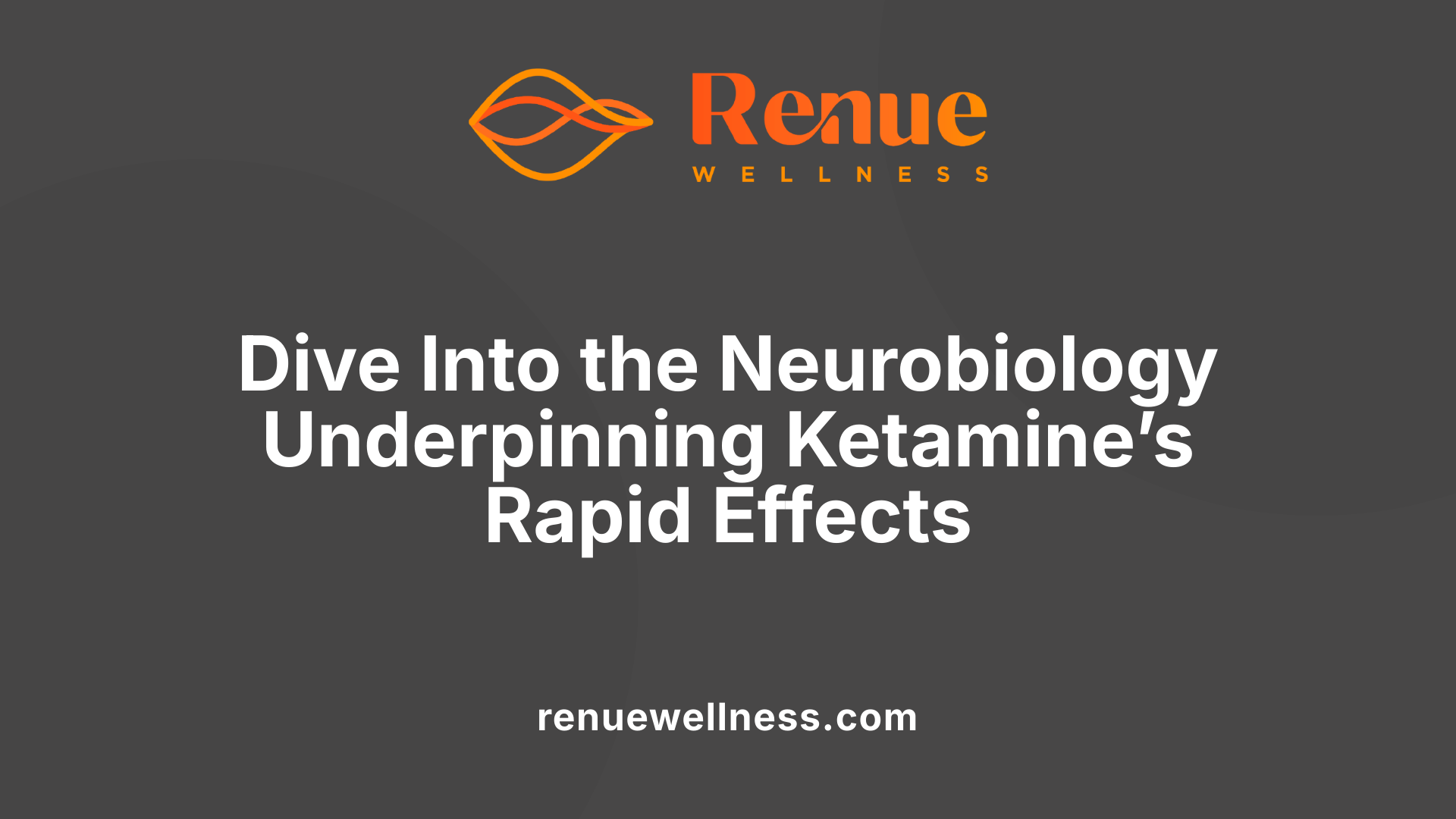Understanding Ketamine’s Rapid Action in Suicidal Ideation


July 31, 2025
Unlocking the Rapid Effects of Ketamine on Suicidal Ideation
Recent research advances have unraveled the neurobiological and clinical mechanisms by which ketamine exerts its swift anti-suicidal effects in depressed patients. This article synthesizes current scientific understanding, highlighting the rapidity of ketamine’s action, the underlying neural circuitry involved, and the implications for emergency psychiatric care.
Mechanisms of Ketamine’s Rapid Action on Suicidal Ideation

How does ketamine compare to traditional treatments for acute suicidal ideation?
Ketamine distinguishes itself from conventional antidepressants by offering a swift reduction in suicidal thoughts. Traditional medications, like selective serotonin reuptake inhibitors (SSRIs), often require several weeks to demonstrate noticeable effects, which can be a critical delay during acute psychiatric crises.
In contrast, studies have shown that ketamine can decrease suicidal ideation within as little as 40 minutes to 24 hours after administration. Multiple clinical trials and meta-analyses confirm these rapid effects, with some reporting significant improvements lasting up to several days or weeks.
One notable study involved 78 patients with major depressive disorder (MDD) and significant suicidal thoughts. It found that a single dose of ketamine led to a rapid decline in suicidal ideation, independent of improvements in depression, and these effects persisted for up to six weeks.
Repeated dosing further enhances the anti-suicidal benefits. For example, infusions administered twice weekly over two weeks resulted in sustained reductions in suicidality and improvements in mood that outperformed traditional care and placebo in controlled trials.
Reassuringly, the safety profile during these studies indicates mild and transient side effects such as dissociation and increased blood pressure, which resolve quickly. This rapid action makes ketamine especially valuable during high-risk periods, such as immediate suicidal crises, where time is of the essence.
Overall, ketamine's ability to deliver immediate relief aligns with the urgent need for effective intervention strategies in suicidal patients, filling a significant treatment gap that traditional therapies often cannot address promptly.
Neurobiological and Pharmacological Foundations of Ketamine's Effects

What are the neurobiological and pharmacological mechanisms behind ketamine’s antidepressant and anti-suicidal effects?
Ketamine’s ability to rapidly alleviate suicidal ideation and depressive symptoms is rooted in specific neurobiological and pharmacological actions. Central to its effect is its role as an NMDA receptor antagonist. By blocking these receptors, which are part of the glutamate system, ketamine leads to an immediate surge in glutamate release. This glutamate surge is crucial because it activates AMPA receptors—another type of glutamate receptor—triggering a cascade of downstream signaling events that foster synaptogenesis (the formation of new synapses) and enhance neuroplasticity.
The activation of neurotrophic factors is essential in this process. In particular, Brain-derived neurotrophic factor (BDNF) is upregulated following ketamine administration. BDNF supports the growth and differentiation of new neurons and synapses, especially in brain areas involved in mood regulation, such as the prefrontal cortex and hippocampus. This neuroplasticity is believed to restore impaired neural circuits associated with depression and suicidality.
Another significant pathway involved is the mammalian target of rapamycin (mTOR) signaling pathway. Ketamine stimulates mTORC1, a key regulator of protein synthesis necessary for synaptic development. Activation of mTOR promotes rapid synaptic growth and functional connectivity in mood-related brain regions, contributing to the swift symptom reduction observed in clinical settings.
Beyond these primary mechanisms, ketamine influences other neurobiological systems involved in depression and suicidal behavior. It modulates serotonergic pathways, involving receptors like 5-HTB, and enzymes such as monoamine oxidase A (MAO-A). It also reduces neuroinflammation and normalizes hypothalamic-pituitary-adrenal (HPA) axis function, which is often dysregulated in depression.
Preclinical and clinical studies further suggest that ketamine impacts traits like impulsivity and aggression—behaviors associated with increased suicide risk—by modulating relevant neural circuits that govern impulse control and emotional regulation.
An intriguing aspect of ketamine’s anti-suicidal action is that it can occur independently of its mood-improving effects. This suggests that ketamine targets specific neurobiological substrates linked to suicidality, separate from those involved in depression per se. In sum, ketamine’s combination of modulating glutamatergic neurotransmission, promoting neuroplasticity via BDNF and mTOR, and influencing neuroinflammatory states constitutes its unique and rapid anti-suicidal mechanism.
Role of Glutamate and Synaptogenesis in Ketamine’s Therapeutic Action
What theories explain the fast-acting therapeutic effects of ketamine?
The rapid therapeutic effects of ketamine are primarily explained by its influence on brain glutamate pathways and the promotion of synaptic connections. Ketamine functions as an NMDA receptor antagonist, which initially leads to a surge of glutamate release in key brain regions involved in mood regulation.
This glutamate surge activates AMPA receptors, a process critical for initiating downstream signaling pathways. Activation of AMPA receptors stimulates cellular mechanisms that increase brain-derived neurotrophic factor (BDNF) release and activate the mammalian target of rapamycin complex 1 (mTORC1), both essential for synaptogenesis—the formation of new synaptic connections.
The enhanced synaptic growth and connectivity in the prefrontal cortex and hippocampus are believed to underpin the rapid reduction in depressive symptoms and suicidal ideation seen with ketamine treatment. These structural changes bolster neural plasticity, allowing the brain circuits involved in mood and stress responses to rewire and recover more quickly.
Neuroplasticity plays a crucial role in sustained remission, with the activity of neurotrophic factors like BDNF maintaining these effects over time. Some research indicates that ketamine metabolites, which act through NMDAR-independent mechanisms, also contribute to its swift antidepressant and anti-suicidal actions.
In summary, the prevailing theories describe ketamine’s effectiveness as stemming from a glutamate surge that triggers synaptic growth and remodeling. This cascade influences the neural circuits that regulate mood, providing an explanation for its rapid onset of action and encouraging further exploration into long-term benefits and mechanisms.
Neural Circuitry and Brain Regions Associated with Antisuicidal Effects

What biomarkers or neural circuitry are associated with ketamine’s anti-suicidal properties?
Research indicates that ketamine's ability to rapidly reduce suicidal thoughts involves complex changes in brain circuits responsible for emotion regulation, mood stabilization, and cognitive processes. Neuroimaging studies have identified specific biomarkers linked to these therapeutic effects.
A key neural correlate of ketamine's anti-suicidal action is the modulation of connectivity between the subgenual anterior cingulate cortex (sgACC) and the right lateral prefrontal cortex (PFC). An increase in the functional connectivity between these regions correlates with clinical improvements, suggesting enhanced top-down emotional regulation. This enhanced communication helps regulate negative emotional states associated with suicidality.
In addition, better connectivity between the right habenula—a brain region involved in processing negative reward signals—and cortical areas has been linked with positive responses to ketamine. This improved circuit communication may diminish maladaptive emotional and motivational patterns, thereby reducing suicidal ideation.
Limbic regions, notably the amygdala and dorsal anterior cingulate cortex (dACC), often exhibit decreased activity and reduced connectivity after ketamine treatment. These regions are central to processing emotional reactions; their dampened activity relates to alleviation of emotional distress and decreased suicidality.
Neurochemical alterations also support these circuit changes. Ketamine enhances glutamatergic neurotransmission, promoting neuroplasticity through the upregulation of brain-derived neurotrophic factor (BDNF) and activation of the mammalian target of rapamycin (mTOR) pathway. These molecular pathways facilitate synaptogenesis and the restructuring of neural networks involved in mood and emotional control.
Furthermore, neuroimaging biomarkers, such as the normalization of activity within the default mode network (DMN) and salience network—both critical in self-referential thinking and emotional processing—have been associated with treatment response. Reductions in inflammatory markers, including interleukin-6 (IL-6) and C-reactive protein (CRP), also correlate with the amelioration of suicidal thoughts, indicating that neuroinflammation may play a role in mood regulation and suicidality.
| Biomarker/Region | Effect Observed | Clinical Implication |
|---|---|---|
| sgACC-PFC connectivity | Increased | Improved emotional regulation |
| Habenula-cortical connectivity | Enhanced | Reduced negative reward signaling |
| Limbic activity (amygdala, dACC) | Decreased | Reduced emotional distress |
| Glutamatergic transmission | Upregulated | Neuroplasticity promotion |
| BDNF and mTOR pathways | Activated | Synaptogenesis and network restructuring |
| Default mode and salience networks | Normalized | Better self-referential processing |
| Inflammatory markers (IL-6, CRP) | Reduced | Potential neuroinflammation targeting |
These neurobiological and neuroimaging indicators present promising insights into how ketamine exerts its rapid anti-suicidal effects. Continued research aims to clarify the causal relationships and identify reliable biomarkers for treatment prediction and monitoring.
Clinical Evidence Supporting Ketamine’s Effectiveness

What is the clinical evidence supporting ketamine’s effectiveness in reducing suicidal thoughts?
Research from multiple randomized controlled trials (RCTs) provides strong evidence that ketamine rapidly diminishes suicidal ideation in depressed patients. A landmark study published in the American Journal of Psychiatry involved 80 adults experiencing suicidal thoughts. Participants received a single intravenous dose of ketamine at 0.5 mg/kg. The results showed a significantly greater reduction in suicidal thoughts within 24 hours in the ketamine group, compared to those receiving midazolam. Specifically, 55% of the ketamine group responded with a ≥50% decrease in the Scale for Suicidal Ideation (SSI), versus 30% in the control group.
Another key trial conducted in France included 156 patients with high suicidal risk. Those receiving ketamine achieved 63% full remission of suicidal thoughts by day 3, compared to just 31.6% in the placebo group. Remarkably, these effects persisted with about 69.5% of patients remaining in remission after six weeks. Such findings highlight ketamine’s ability to produce rapid, durable reductions in suicidal ideation, especially prominent in bipolar disorder and treatment-resistant depression.
Systematic reviews and meta-analyses consolidating data from 10 to 14 studies further affirm ketamine's efficacy. They report large effect sizes, with standardized mean differences around 0.75 to 0.92 at 24 hours and up to 7 days post-treatment. The benefits often emerge within hours, sometimes as early as 40 minutes, and can last days or even weeks.
Emerging evidence from large retrospective cohort studies underscores that ketamine prescription correlates with a significant decrease in suicidal ideation across real-world populations. For example, one extensive study involving over 500,000 patients noted risk reductions lasting up to 270 days post-treatment.
In addition, phase II/III trials are currently exploring optimal dosing, frequency, and long-term safety, with preliminary data indicating repeated infusions can extend remission periods. Overall, these findings establish ketamine as a promising emergency and adjunct treatment for patients experiencing acute suicidal thoughts, with rapid onset and meaningful short-term benefits supported by rigorous clinical research.
Randomized controlled trials
| Study/Location | Participants | Dose | Primary Outcome | Results | Duration of Effect |
|---|---|---|---|---|---|
| Columbia University | 78 with MDD and SI | 0.5 mg/kg IV | Change in SSI at 24 hours | Greater reduction in SSI, Cohen’s d=0.75, 55% responders | Up to 6 weeks |
| French Hospitals | 156 with high suicide risk | 0.5 mg/kg IV | Full remission of SI by day 3 | 63% remission vs. 31.6% in placebo | Coherent with 6 weeks |
| Meta-analysis (7 RCTs) | 407 patients | 0.5 mg/kg IV | SI reduction within 1-7 days | Consistent, moderate to large effects | At least 7 days |
Remission rates and effect sizes
| Study Type | Response Rate | Effect Size (Cohen’s d or SMD) | Duration |
|---|---|---|---|
| Individual RCTs | 55-63% | 0.75 (moderate) | 24 hours to 6 weeks |
| Meta-analyses | Variable but significant | Ranges from 0.34 to 0.92 | Up to 1 week or more |
Duration of anti-suicidal effects
While the initial reduction in suicidal thoughts is rapid, lasting from hours to days, some evidence points to effects persisting for weeks, especially with repeated dosing. Follow-up periods in studies range up to 6 weeks, with ongoing trials aiming to assess long-term safety and efficacy.
Comparisons with placebo and midazolam
Most trials compare ketamine to controls like saline or midazolam. While ketamine consistently outperforms placebo in reducing SI within 24 hours, some studies, including one in France, reported no significant difference between ketamine and midazolam in immediate effects, although both showed rapid benefits. This highlights the need for further research to distinguish ketamine's specific anti-suicidal mechanisms from its general sedative effects.
Overall, the clinical evidence underscores ketamine’s capacity to produce rapid, meaningful reductions in suicidal ideation, supported by robust trial data and systematic reviews. Its effects emerge within hours, often lasting days to weeks, making it a vital tool in crisis intervention settings alongside continued clinical management.
Long-Term Efficacy and Safety of Ketamine Treatments
Repeated infusions and sustained benefits
Research indicates that administering ketamine repeatedly over a period can lead to longer-lasting relief from suicidal ideation. Clinical trials involving multiple infusions—such as twice-weekly treatments over two weeks—have demonstrated that the initial rapid reductions in suicidal thoughts are enhanced and prolonged with ongoing therapy. Patients often experience continued symptom improvement, with some maintaining benefits for several weeks or even months, especially when combined with other treatment modalities. The cumulative effect of repeated doses seems to support neuroplasticity and reinforce neural circuits involved in emotional regulation, mood stabilization, and cognition.
Long-term safety data
While short-term safety profiles of ketamine are well-established—most side effects being transient and mild—comprehensive long-term safety data are still emerging. Longitudinal studies and cohort analyses, such as those from large healthcare networks, suggest that ketamine's safety omits major adverse effects over periods extending beyond several months. However, concerns persist regarding the potential for misuse, dependency, and neurotoxicity with chronic use. Some reports warn about possible cognitive impairments or urinary tract issues after prolonged exposure, though these are typically associated with higher doses or non-medical use. Current evidence underscores the importance of controlled administration under medical supervision to mitigate risks.
Potential risks and adverse effects
Despite promising benefits, ketamine therapy carries potential risks. Common adverse effects include dissociation, increased blood pressure, dizziness, and nausea, generally resolving shortly after infusion. Rarely, more serious concerns such as urinary issues, cognitive disturbances, or exacerbation of psychotic symptoms may occur, particularly with repeated high doses or in vulnerable populations. Treatment protocols aim to minimize these effects via careful dosing, screening, and monitoring.
Need for further research
Although recent studies and meta-analyses support ketamine's rapid anti-suicidal effects and potential for sustained benefits, many questions remain. Optimal dosing schedules, long-term safety, and mechanisms of durability are areas needing further investigation. Specifically, research should focus on identifying biological markers—such as neuroimaging signatures or inflammatory markers—that predict long-term response. Understanding individual variability in treatment response, potential long-term adverse effects, and the risk of dependency is crucial for developing safe, effective, and personalized treatment protocols. Ongoing clinical trials that integrate neuroimaging, biological, and psychological assessments aim to fill these knowledge gaps.
Biomarkers and neural circuitry associated with ketamine’s anti-suicidal effects
Studies reveal that ketamine’s anti-suicidal properties are linked to specific neural circuit modifications. Notably, improved connectivity between the subgenual anterior cingulate cortex (sgACC) and the right lateral prefrontal cortex (PFC), crucial regions in emotional regulation, correlates with symptom reduction. Enhanced connectivity between the right habenula—a brain region involved in reward processing and aversion—and cortical areas also predicts positive outcomes. Conversely, decreased activity and connectivity within limbic structures such as the amygdala and dorsal anterior cingulate cortex (dACC) are associated with reductions in emotional distress and suicidal thoughts.
Neurochemical changes underpin these neural circuit modifications. These include increased glutamatergic transmission, stimulating BDNF (brain-derived neurotrophic factor) release, and activating the mTOR pathway, which promotes synaptogenesis and neuroplasticity. Neuroimaging biomarkers further support these findings, showing normalized activity within the default mode network (DMN) and salience network—often dysregulated in depression and suicidality—and reductions in inflammatory markers like IL-6 and CRP, which are linked to emotional regulation. These neurobiological signatures reinforce the role of ketamine in modulating both structural and functional neural pathways associated with suicidality.
Future Directions and Research Needs

What are the neurobiological and pharmacological mechanisms behind ketamine’s antidepressant and anti-suicidal effects?
Ketamine’s impressive and rapid effects on depression and suicidal ideation are believed to stem from complex neurobiological and pharmacological processes. Its primary mechanism involves blocking NMDA receptors, which are critical for regulating glutamate, the main excitatory neurotransmitter in the brain.
This receptor antagonism results in a surge of glutamate release, which then activates AMPA receptors, facilitating neuroplasticity. Key signaling pathways, such as the mammalian target of rapamycin (mTOR) and the brain-derived neurotrophic factor (BDNF), are stimulated, promoting the growth of new synapses. These processes help restore the functioning of brain regions involved in mood regulation, especially the prefrontal cortex and hippocampus.
Beyond glutamate pathways, ketamine also influences neurobiological systems linked to suicidality. It modulates serotonergic transmission, including serotonin transporter activity (e.g., 5-HTB receptors), and inhibits enzymes like monoamine oxidase A (MAO-A), which degrade mood-related neurotransmitters.
Inflammation in the brain has been associated with depression and suicidal behaviors. Ketamine appears to exert anti-inflammatory effects, reducing neuroinflammatory responses linked to mood disorders.
Further, ketamine impacts the hypothalamic-pituitary-adrenal (HPA) axis, helping to normalize stress response mechanisms that are often dysregulated in depressed and suicidal patients.
Preclinical studies suggest that ketamine affects traits such as impulsivity and aggression. These are significant because they are related to increased risk for suicidal acts and are mediated by neural circuits controlling impulse control.
Interestingly, some effects of ketamine in reducing suicidal thoughts seem to be partly independent of improving overall mood. This indicates that distinct neural and molecular pathways are involved, making ketamine a promising tool for targeting suicidality specifically.
Overall, ketamine’s multi-pathway action on glutamate neurotransmission, neuroplasticity enhancement, anti-inflammatory effects, and modulation of other neurochemical systems collectively contribute to its potential as a rapid anti-suicidal treatment. Understanding these mechanisms is crucial for developing more targeted therapies and optimizing treatment protocols to maximize benefits while minimizing risks.
The Promise and Challenges of Ketamine in Suicide Prevention
While ketamine’s rapid anti-suicidal effects offer a life-saving breakthrough, understanding its precise mechanisms and optimizing its long-term safety remain crucial. Continued research into neural circuitry, biomarkers, dosing strategies, and neuroplasticity pathways will help refine ketamine’s role in psychiatric emergency care. As the scientific community explores these frontiers, ketamine’s potential to transform suicidality treatment continues to grow, promising new hope for at-risk populations.
References
- Ketamine Rapidly Improves Cognitive Function Making Those in ...
- The rapid anti-suicidal ideation effect of ketamine: A systematic review
- Ketamine for rapid reduction of suicidal thoughts in major depression
- A meta-analysis of the effects of ketamine on suicidal ideation in ...
- Understanding and Treating Suicidal Ideation With Ketamine
- Is ketamine efficacious for rapid treatment of acute suicidal ideation ...
- Ketamine for the acute treatment of severe suicidal ideation - The BMJ
- Ketamine for Rapid Reduction of Suicidal Thoughts in Major ...
Recent Posts
Conditions Treated
AnxietyDepressionOCDPTSDPostpartum DepressionPain ManagementSubstance AbuseSuicidal IdeationOur Location


